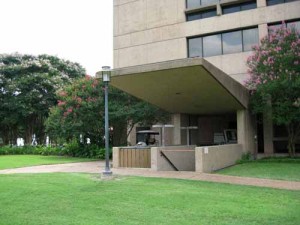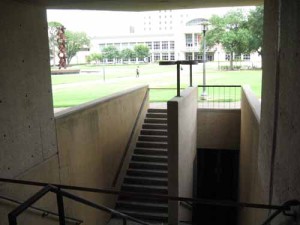
Have you noticed the stairs to nowhere? Hiding in plain sight, in the center of the University of Houston campus, next to Philip G. Hoffman Hall, a concrete canopy protects the entrance to what looks like a Cold War bomb shelter. Now abandoned and gathering debris, this is a relic of the university’s soured love affair with underground buildings.
In the 1960s, the campus assumed a more suburban look; new buildings were widely-spaced, separated by expansive lawns and groves of trees. To preserve this park-like setting, university planners tried to hide new buildings beneath lawns or plazas. It was all very logical: A plot of land did double-duty, allowing the university to capture usable space for activities without losing precious open space outdoors.
During this period four buildings and parts of others were placed underground, but by 1980 this fad had run its course. What happened? Public tastes changed as Modern architecture, which brought us the underground buildings, lost favor to more traditional styles. More importantly, university planners recognized the dangers of flooding in low-lying Houston. Flooded streets have always been a nuisance, but flooding from Tropical Storm Allison in 2001 was unprecedented and caused millions of dollars in damage to campus buildings. Today the university does not put buildings underground, and new buildings do not have basements.
But in case you missed them, here are the present and former structures beneath our feet:
University Computing Center (early 1960s)
Buried a few yards north of the Ezekiel Cullen building is a facility that began life in the 1960s as the University Computing Center. When the university moved its mainframe computers to a new building on Elgin Street in 1976, this area became an office annex for E. Cullen. Allison filled it with water. Rather than repair the damage, the university locked the doors and abandoned it.
University Center Annex (1965)
In the mid-1960s the university spent a lot of money to dig a huge hole next to the University Center for an underground annex topped by a plaza. Fifty years later, as part of the UC renovations, the university spent a lot of money to fill in the hole and build the replacement structure on top of it. It has no basement level.
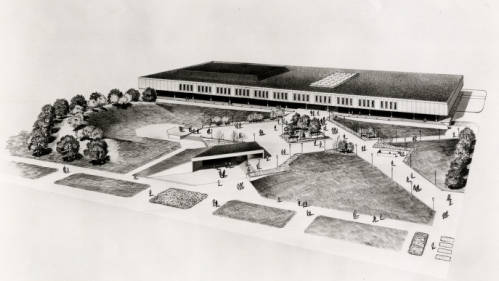
Architectural rendering of University Center with underground annex in foreground, mid 1960s. Photo courtesy of UH Buildings Collection, Digital Library.
Agnes Arnold Hall (1968)
From the south, Agnes Arnold Hall, a mid-rise tower, appears to rise from a large open courtyard located below street level. The building is reached by a bridge, which spans the courtyard below. In Allison the courtyard, a basement-level lecture hall, as well as elevators and escalators, were all flooded.
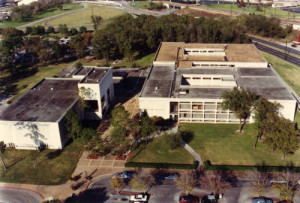
UH Law Center. Large plaza in background covers underground library. Central courtyards in classroom buildings on right also cover underground libraries. Photo courtesy UH Buildings Collection, Digital Library.
Law Center (1970)
The UH Law Center opened in the early 1970s with a group of two-story classroom buildings clustered around a large plaza. Beneath the plaza was the law library. Each of the classroom buildings had an atrium-courtyard; below it was a satellite library in the basement. In Allison the entire lower level flooded, causing catastrophic damage to the library collections.
University Center Satellite (1973)
As the campus expanded to the northwest, university planners grouped the new science and fine arts buildings around a grassy quadrangle. Beneath this lawn was the new University Center Satellite, which provided dining and recreational facilities for students on this end of the campus. This building was inundated in Allison and remained closed for repairs for more than a year.
Hilton Hotel Parking Garage (early 1970s)
When the University Hilton and the adjoining School of Hotel and Restaurant Management were built in the 1970s, the complex included a parking garage. The garage is under the building, reached by a steep ramp from the street. Like all of the other underground structures, it flooded in Allison.
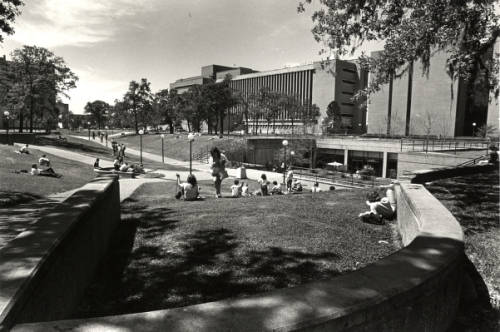
Students lounge outside UC Satellite, circa 1980. Sloped lawn directs water toward entrance. Photo courtesy UH Buildings Collection, Digital Library.
The University of Houston Special Collections is proud to announce the publication of a new finding aid for the Herman George Eiden Papers. Sara Wheeler, graduate student intern from the Simmons School of Library and Information Science, has recently completed the processing of the papers, penned the new finding aid, was generous enough to share her thoughts on the new collection below, as well as present some highlights from the collection via a small exhibition currently on display at the entrance to Special Collections, near the Morrie & Rolaine Abramson Grand Staircase.
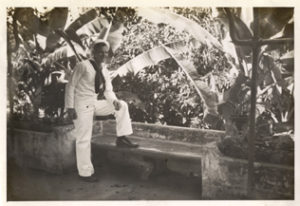
At the aquarium, Manila, Philippines, November 1940 (Herman George Eiden Papers)
In 1939, 18-year-old Herman George Eiden joined the United States Navy. Like many his age, Eiden had the opportunity to see the world through his service. Eiden was able to take photographs of his travels, send letters home, and even film some of his travels. He was able to do this all while aboard the USS Lexington and then USS Houston (CA-30). The University of Houston Special Collections recently received the donation of these photo albums, scrapbooks, films, and letters of Eiden’s for inclusion among the USS Houston & Military History collections.
The Herman George Eiden Papers include three photo albums, memorabilia, and clippings that Eiden put together and sent home to his family in Louisville, Kentucky. In the photos, Eiden captured his travels to Panama, Hawaiʻi, Guam, China, and the Philippines. Most of his time was spent in the Philippines, where he and his shipmates were able to take in the local color, enjoying sightseeing trips to places such as Old Manila, Pasig River, and Pagsanjan Falls.
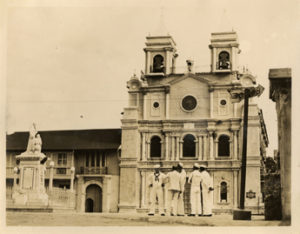
Church of the Third Order of the Franciscans (Herman George Eiden Papers)
The photos include life aboard the USS Houston (CA-30). There are images of Navy sailors swimming off the side of the ship, boxing matches, as well as pictures of the ship’s band. Also included are photos of the changing of command, as Captain Rooks takes over for Captain Oldendorf.
Eiden also sent six film reels home. These film reels have all been digitized to allow quick and easy access for contemporary scholars. Along with the reels, Eiden included a narrative log that provides details to correspond with each part of the film.
While serving in the Navy, Eiden achieved the rank of Fireman First Class. He was aboard the ship during the Battle of the Java Sea and the USS Houston’s final battle, the Battle of Sunda Strait. Eiden, alongside 692 of his comrades, perished during this attack on March 1, 1942.
After the sinking of the USS Houston, it took almost nine months for news of the fate of the ship and her crew to reach home. Eiden’s family saved his obituary and news articles about the sinking of the USS Houston (CA-30) that were published in their local newspaper, The Courier-Journal of Louisville.
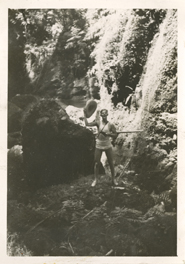
“Well, so long! Hope you have enjoyed my pictures.” Herman George Eiden, February 1941 (Herman George Eiden Papers)
One of his sisters, Clara Imelda Eiden Sivori, also received the USS Houston (CA-30) Survivors Association and Next Generations newsletters, which are a part of the collection. She and other relatives were able to attend the 60th commemorative ceremony in Houston for the USS Houston (CA-30) and those photos are also included in the collection.
Those interested in getting a closer look at the Herman George Eiden Papers are encouraged to see it in person by visiting our reading room, as well as visiting the two exhibit cases just outside of the entrance to Special Collections where select materials are on display for a limited time. Finally, those interested in more information on this collection or the Cruiser Houston Collection should contact Christian Kelleher, Head of Special Collections and curator of the USS Houston & Military History collections.
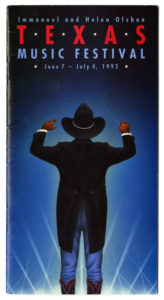
Program from the Immanuel and Helen Olshan Texas Music Festival Records, 1992
Each summer the Immanuel & Helen Olshan Texas Music Festival provides an opportunity for talented young musicians to come together and learn from professional musicians as well as faculty from the Moores School of Music. This year’s festival performances kicked off June 11 and run through July 2.
In 2013, the University Archives acquired records documenting the history of this distinctive program. The recently processed Immanuel and Helen Olshan Texas Music Festival Records contain concert programs, publicity and press materials, a scrapbook, as well as concert recordings covering the history of the festival from 1985 to 2013.
In addition to documenting a vital part of the city and the University’s musical landscape, the Immanuel & Helen Olshan Texas Music Records also exemplify the changing nature of the archival record, and the challenges repositories face along with it. While the paper portion of the TMF records is comparatively small, the records also include over 200 digital recordings. These recordings arrived on CDs, an unstable media not suitable for long-term archival storage. The TMF records arrived just as the department was beginning to explore in earnest methods for accessioning born digital materials and transferring files to secure digital archival storage. As Special Collections has continued to acquire collections containing a variety of digital media formats, we continue to improve our processes for preserving, describing, and providing access to these materials.
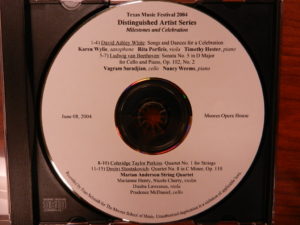
Texas Music Festival Distinguished Artist Series Milestones and Celebration concert recording, June 8, 2004
For now, the digital concert recordings are minimally described in the finding aid with an overview of what is available, including the date range of recordings. Researchers, performers, or fans wanting to get more detail on the recordings—including dates, soloists and conductors, and pieces played for specific concerts—are encouraged to contact University Archivist Mary Manning with inquiries. With advance request, the concert recordings can be made available for listening on a computer in our reading room.
As they record a dynamic cultural and educational event, it is only appropriate that the Immanuel and Helen Olshan Texas Music Festival Records also help orchestrate a transition in the archives to a new era in collecting, preserving, and making accessible our cultural heritage.
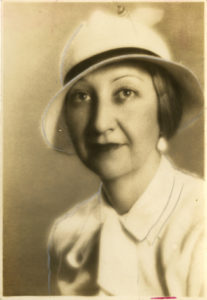
undated portrait of Joyce Burg, from the Betty Trapp Chapman Papers
The University of Houston Special Collections is proud to announce the publication of a new finding aid for the Betty Trapp Chapman Papers. Emily Brooks, Graduate Assistant for the Carey Shuart Women’s Archive, has recently completed the processing of the papers, penned the new finding aid, and was generous enough to share some of her thoughts on the new collection.
In 2004, Ellen Elkins Grimes, Chair of the Women in the Profession Committee of the State Bar of Texas was asked to give a speech about the history of female lawyers who paved the way for today’s women in law. She quickly realized that there was very little information available, especially regarding the early female pioneers of the law in Texas. She decided that the State Bar association should sponsor a book on the history of Texas female lawyers and appointed Betty Trapp Chapman, a prominent Houston historian to complete the research and writing of what would become Rough Road to Justice: The Journey of Women Lawyers in Texas (2008). Chapman is the author of several books on Houston and Texas history such as Historic Houston (2011) and Houston Women: Invisible Threads in the Tapestry (2000).
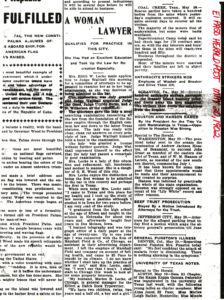
“A Woman Lawyer” (El Paso Herald Post, May 20, 1902, Betty Trapp Chapman Papers)
From Edith Locke, the first woman licensed to practice in El Paso in 1902, to nationally prominent Texas women like Sandra Day O’ Connor, Kay Bailey Hutchinson, and Sheila Jackson Lee, Rough Road to Justice tracks the journey of these women as they overcame discrimination and harassment to succeed in the legal profession. Chapman explores broad social issues that impacted women in the legal profession as well as individual trailblazers that made it possible for women to pursue careers in law today. One such woman was Joyce M. Burg, the first woman to practice law in Houston after she graduated from the University of Texas Law School in 1926 – one of only four women in her class. She went on to become the “grand dame of Houston’s family law system,” practiced law for 60 years and founded the Harris County Women Attorneys Association. When she passed away in 1997 at the age of 96, she was the oldest member of the Houston Bar Association.
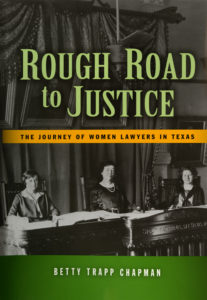
cover of Rough Road to Justice: The Journey of Women Lawyers in Texas (2008)
This collection enriches the Carey C. Shuart Women’s Archive and Research Collection with the often-untold stories of Texas women in the law, unique correspondence with these women and their descendants, as well as original photographs of several of the women featured in Rough Road to Justice. For more information, we invite you to visit our reading room where the Betty Trapp Chapman Papers can be explored.
